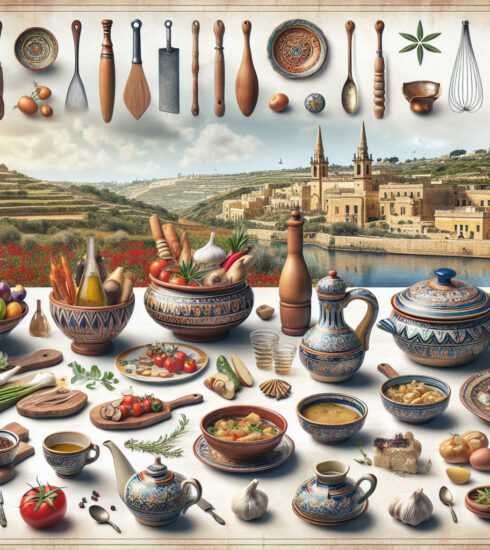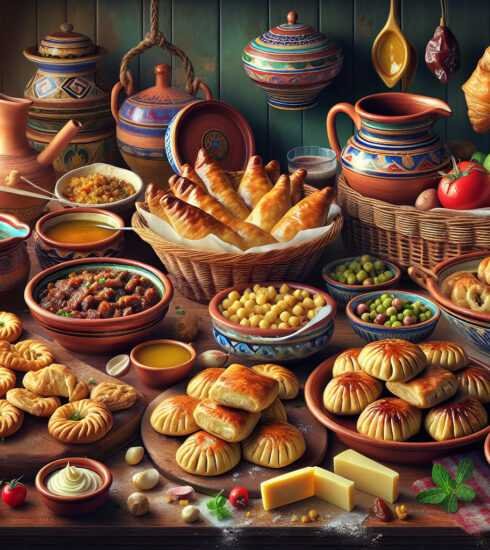Delve into Maltas Culinary Heritage: Unveiling a Melting Pot of Flavors in this Captivating Article
The Cultural Fusion in Malta’s Culinary Heritage
Malta’s culinary heritage is a true reflection of its rich and diverse history. Situated in the heart of the Mediterranean, this small archipelago has been a melting pot of cultures, with influences from the Phoenicians, Romans, Arabs, Normans, Sicilians, and British, among others. This fascinating blend of cultures has had a profound impact on the country’s culinary traditions, resulting in a truly unique and vibrant cuisine that is a delight for food lovers.
The Origins of Maltese Cuisine
Maltese cuisine has deep roots in traditional Mediterranean fare, with a distinct Maltese twist. The islands’ geographical location has played a crucial role in shaping its culinary heritage. As a crossroads between Europe, Africa, and the Middle East, Malta has benefited from a wide array of ingredients and cooking techniques. Many staple ingredients in Maltese cuisine, such as olive oil, garlic, tomatoes, and fish, can be traced back to ancient times.
Arab Influence
Malta’s close proximity to North Africa and its historical Arab rule have left a significant mark on the local cuisine. The Arabs introduced new ingredients and techniques, such as spices, almonds, citrus fruits, and sweet pastries, which are still prevalent in modern Maltese dishes. One of the most iconic dishes of this Arab influence is Imqaret, a sweet pastry made with dates and deep-fried.Sicilian Influence
Due to its proximity to Sicily, Malta has had a long-standing cultural and culinary exchange with its neighboring island. The Sicilian influence on Maltese cuisine can be seen in dishes such as Timpana, a baked pasta dish with a rich meat sauce, and Cannoli, a sweet pastry filled with ricotta cheese. Maltese ravioli, known as Ravjul, also bear a striking resemblance to their Sicilian counterparts.British Influence
Malta’s 150-year colonial rule under British administration has left an indelible mark on the local food culture. The British introduced many staples of their own cuisine, such as tea, sandwiches, roast beef, and puddings. Traditional Maltese breakfast, for example, often includes tea, toast, and cereals, reflecting the British influence.
Maltese Street Food
One of the best ways to immerse yourself in Malta’s culinary fusion is through its vibrant street food scene. The streets of Valletta and other towns come alive with the aromas and flavors of various street foods, each with its own unique history and cultural significance. Here are some must-try street food dishes that showcase the cultural fusion in Maltese cuisine:
Pastizzi
Pastizzi, a popular Maltese street food snack, is a delicious example of the Arab influence on the local cuisine. These flaky pastries are filled with ricotta cheese or mushy peas and are baked until golden brown. Best enjoyed fresh from the oven, pastizzi are a staple of Maltese street food culture and can be found in almost every corner bakery.Hobz biz-zejt
Hobz biz-zejt, meaning “bread with oil” in Maltese, is a simple yet flavorful street food dish that showcases the Mediterranean ingredients at the heart of Maltese cuisine. This open-faced sandwich is made with crusty Maltese bread, rubbed with garlic and tomatoes, drizzled with olive oil, and topped with a variety of toppings such as tuna, capers, olives, and fresh herbs. It is a refreshing and satisfying snack, perfect for a quick bite on the go.Fenkata
Fenkata is a traditional Maltese meal that originated from the British tradition of hunting rabbits, which were plentiful on the islands. This dish demonstrates the fusion of British and Mediterranean influences. Fenkata typically consists of rabbit stewed in a rich tomato and wine sauce, accompanied by roast potatoes, vegetables, and bread. It is a hearty and flavorful dish that is cherished by the locals.Maltese Cuisine
Beyond street food, Maltese cuisine offers a treasure trove of traditional dishes that highlight the cultural fusion in Malta’s culinary heritage. Here are some of the most renowned dishes that represent the diverse influences on Maltese cuisine:
Bragioli
Bragioli is a classic Maltese dish that showcases the country’s Sicilian influence. It consists of thin slices of beef rolled with bacon, onions, garlic, and herbs, then simmered in a flavorful tomato sauce. Bragioli is usually served with pasta or rice, making it a satisfying and hearty main course.
Soppa tal-Armla
Soppa tal-Armla, or Widow’s Soup, is a traditional Maltese soup that has its roots in Arab cuisine. It is a thick and hearty soup made with lentils, vegetables, and pasta, flavored with garlic, onions, and herbs. Served with a drizzle of olive oil and a sprinkle of grated Parmesan cheese, this soup is a comforting and nourishing meal, perfect for cold winter days.Maltese Rabbit Stew
Maltese Rabbit Stew, or Stuffat tal-Fenek, is the epitome of the island’s culinary fusion. This dish combines the British tradition of cooking rabbit with Mediterranean flavors and ingredients. The rabbit is marinated in red wine, garlic, and herbs before being slowly braised in a rich tomato sauce. Served with crusty bread or roasted potatoes, this dish is a beloved staple of Maltese cuisine.The Future of Maltese Cuisine
Malta’s culinary heritage is a testament to the country’s history and cultural diversity. The fusion of Arab, Sicilian, British, and other influences has shaped a unique and vibrant cuisine that continues to evolve. Today, Maltese chefs are taking traditional dishes and infusing them with contemporary twists, using locally sourced ingredients and innovative techniques.
Malta has also seen a rise in culinary tourism, with visitors flocking to the island to experience its rich culinary heritage firsthand. Culinary tours, cooking classes, and food festivals have become popular attractions, offering a deeper insight into the cultural fusion in Maltese cuisine.
As the world becomes more interconnected, the cultural fusion in Malta’s culinary heritage is likely to continue evolving. The island’s location as a crossroads of cultures makes it a culinary melting pot, with new influences and flavors constantly being introduced. Whether you’re a food lover or a history enthusiast, exploring Malta’s culinary heritage is a truly enriching experience.
Internal Links:External Link:For more information on Maltese cuisine and its links to the country’s history, you can visit the Wikipedia page on Maltese cuisine.






